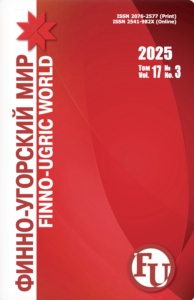Pavlova Anzhelika N.,
Doctor of History, Head of the Department of History and Psychology, Volga State University of Technology (Yoshkar-Ola, Russia), angpan@rambler.ru
Pechnikov Andrei O.,
Senior Lecturer, Department of History and Psychology,
Volga State University of Technology (Yoshkar-Ola, Russia), peschnikovao@volgatech.net
Introduction. The period from the I millennium BC till the beginning of II thousand AD takes a special place in the history of the Finno-Ugric Volga region as the time of formation of the Mari and Mordovian ethnic groups, their material and spiritual culture. The aim of the work is to study and generalize the experience of the presentation of the material culture of the Finno-Ugrians of I millennium BC. till the beginning of II thousand AD in the museums of the Volga region. It involves the following tasks: to determine the features of building the archaeological part of the exposition of museums, identify the items of material culture of Finno-Ugric peoples of the period and the features of their exposure.
Materials and Methods. The research employs both philosophical and general research methods.
Results and Discussion. Material culture of Finno-Ugrians of I millennium BC – the beginning of II thousand AD is represented in the museums of the Finno-Ugrian republics, as well as Tatarstan and Chuvashia. Republican museums conduct great educational and educational work. That determines the construction of the main part of the expositions in accordance with the chronological principle, which allows consistently introduce the stages of the history of the region, since ancient times. An exception is thematic exhibitions that reveal one or another side of the ancient culture of the ethnic groups.
Conclusion. The museums have different capacities (material and technical) to represent the ancient objects of material culture, which is associated with the size of the premises, and with the accents of the expositions themselves, when archaeological departments perform different roles.
Key words: museum; Finno-Ugrians; material culture; revitalization; early Iron Age; the Middle Ages.
For citation: Pavlova AN, Pechnikov AO. Osobennosti muzejnoj prezentacii material’noj kul’tury finno-ugrov Povolzh’ja I tys. do n. je. – II tys. n. je. [Features of museum presentation of material culture Finno-Ugrians of the Volga I thousand BC e. – II thousand AD e.]. Finno-ugorskiy mir = Finno-Ugric World. 2017; 1: 110–115. (In Russ.)
- Bolshov SV, Bolshova NA, Danilov OV. Drevnie kul’tovye pamjatniki Marij Jel (po arheologicheskim, jetnograficheskim, fol’klornym i istoricheskim istochnikam): monografiya [Ancient cult monuments of Mari El (on archaeological, ethnographic, folklore and historical sources): monograph]. Yoshkar-Ola; 2008. (In Russ.)
- Danilov OV. Yazycheskie kul’ty drevnego naselenija Marijskogo Povolzh’ja [Pagan cults of the ancient population of the Mariyskaya Volga Region]. Yoshkar-Ola: Mar. kn. izd-vo; 2016. (In Russ.)
- Yefimenko PP. Srednevolzhskaya ekspeditsiya 1926–1927 g. [Mid-Volga Expedition 1926–1927]. Soobshcheniya Gosudarstvennoy akademii istorii material’noy kul’tury. = Reports of the State Academy of the History of Material Culture. Leningrad; 1929; 2: 168–174. (In Russ.)
- Markov VN. Anan’inskaya problema. Nekotoryye itogi i zadachi yeye resheniya [Ananyinskaya problem. Some results and tasks for its solution]. Pamyatniki drevney istorii Volgo-Kam’ya= Monuments of the ancient history of the Volga-Kama region. Kazan; 1994: 48–88. (In Russ.)
- Mordovskii respublikanskii ob”edinennyi kraevedcheskii muzei [Mordovian Republican Local History Museum]. Saransk: Tip. “Krasnyy Oktyabr’”; 2003. (In Russ.)
- Myasnikov NS. Etnokul’turnyye protsessy v Chuvashskom Povolzh’ye v I–VIII vekakh nashey ery v svete arkheologicheskikh dannykh [Ethnocultural processes in the Chuvash Volga region in the 1st–8th centuries AD in the light of archaeological data]. Nauchnyye doklady / Chuvash. gos. in-t gumanitar. nauk= Scientific reports / Chuvash State Institute of Humanities. Cheboksary; 2013: 3. (In Russ.)
- Pavlova AN. Semantika ukrasheniy drevnemariyskogo kostyuma: monografiya [Semantics of the ornaments of the ancient Marian costume: monograph]. Yoshkar-Ola: RITS PGTU; 2008. (In Russ.)
- Patrushev VS. Mariyskiy kray v VII–VI vv. do n. e. (Starshiy Akhmylovskiy mogil’nik) [Mari Region in the 7th–6th centuries BC. (Senior Ahmylovsky burial ground)]. Yoshkar-Ola: Mar. kn. izd-vo; 1984. (In Russ.)
- Patrushev VS. Mogil’niki Volgo-Kam’ya ranneanan’inskogo vremeni [Cemeteries of the Volga-Kamia of the Early Ananian Period]. Kazan: OOO “Foliant”; In-t istorii AN RT; 2011. (In Russ.)
- Patrusheva TS. Arkheologicheskomu muzeyu Mariyskogo gosudarstvennogo universiteta – 20 let [20 years to Archaeological Museum of the Mari State University]. Mariyskiy arheografichesky vestnik = Mari archology newsletter. Yoshkar-Ola; 2009: 285–286. (In Russ.)






















